You're using an outdated browser. Please upgrade to a modern browser for the best experience.
Please note this is an old version of this entry, which may differ significantly from the current revision.
Subjects:
Archaeology
The Nara period in Japan was a short but volatile historical era that left behind a huge amount of cultural property across the country. Most of the related sites have been recognized by UNESCO as deserving of World Cultural Heritage status or are classified by the Japanese government as particularly important national heritage. This is especially true of the Nara Palace site, with its outstanding conservation achievements and reconstruction of Japanese architectural heritage.
- authenticity
- Nara Palace site
- 1994 Nara Document
- architectural heritage DNA
- conservation
1. Brief History of the Pre-Nara Period and the Establishment of the Nara Palace Site
Japan’s territory consists of four main islands; the northernmost region is Hokkaido, the central area is Honshu main island, and the southern region comprises Kyushu and Shikoku. These four islands are divided into eight regions, grouped according to geographical and cultural characteristics from north to south, comprising Hokkaido, Tohoku, Kanto, Chubu, Kansai, Chugoku, Shikoku, and Kyushu, of which Kansai (ancient name: Kinki) is located in the south of Honshu main island, which includes the Nara district today (Figure 1). The southern area of the Kansai region has a peninsular climate, with an average temperature of 15 degrees Celsius and an average annual rainfall of 1200–1300 mm per year, while the northern area has the Odaigahara plain, which is characterized by a mountainous climate, with an average temperature of 10 degrees Celsius and an average annual rainfall ranging from 2500 to 3000 mm per year.
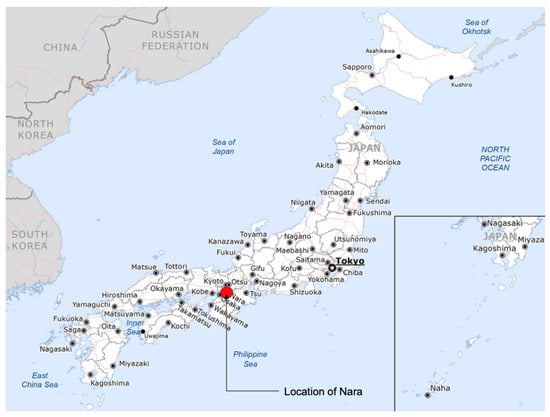
Figure 1. Location of the Nara area.
The Nara (奈良) area has a long history in Japan, possibly starting from the Yayoi era (2nd century BCE–3rd century CE) [1]. This area was reclaimed, settled, and developed by humans for agricultural production on a large scale. Next, at the beginning of the Kofun period (300–710 CE), a center of political power was formed and developed in this area. By the 4th century CE, the area had developed into a major center of political power, in the form of a confederated state known as Yamato Japan (this political center was in the area of the present-day Nara district). During this period, Yamato Japan’s territory only included the Kyushu and Kansai regions (except for Kanto, Tohoku, and Hokkaido). In the 6th century CE, a new national center, representing Japan’s first organized political community led by a government, was established (known as the Yamato Court) in the Asuka district, located on the northern side of the Nara area. This period is known as the Asuka period (5th century—645 CE), according to the accepted divisions of Japanese history [2].
Starting from this period, Chinese civilization and Buddhism spread widely throughout Japan, creating strong technological development and profound changes in political institutions and social structures. A new government was created with a national administrative management system following the Chinese model that functioned under the Emperor’s aegis known as Tennou (天皇). This important historical situation created an economic and political foundation for the establishment of the ancient Nara capital city (710–784 CE). The Tennou had to frequently move the capital to protect imperial power, avoiding the control of other political forces that had gradually emerged from influential families in Japanese society at that time. However, those families eventually seized power and took control of the entire country. Two powerful families appeared during these periods, including the Soga family (Kofun period) and the Fujiwara family (Nara and Heian periods) [3]. The Tennou lost their political power and gradually became a cultural and religious symbol of the nation. However, the great Prince Shotoku (574–622 CE) appeared after Empress Suiko had ascended to the throne as the first Queen of Japan (593 CE). Prince Shotoku took over political power as regent and became an important political leader of the country, exerting great influence in Japanese society. He played an important role in bringing Chinese civilization to Japan and promoting Buddhism; he wrote 17 articles on ethics and the basic political principles of the first constitution of Japan. Concurrently, Confucianism and Taoism were officially disseminated in Japan during these periods.
Later, Kanzi (old Chinese) characters (漢字) were introduced to Japan and became the official writing system, and coins using the Chinese model were issued, along with the establishment of national transportation systems by horse, public markets and a school system following the Chinese model, while the development of agricultural techniques brought abundant material wealth to the society. Japan became a prosperous country, and its territory was expanded north and south (except in Hokkaido and Okinawa). During these periods, Japan sent out envoys and set up an embassy in China, with the intention of expressing admiration for the Chinese Emperor and absorbing Chinese civilization into Japan.
Around 710, Japan’s first large-scale Heijokyo capital city (平城京, the “Nara Palace Site”) (Figure 2 and Figure 3) was built, copying the model of the Chinese Chang’an capital city (長安京, Tang dynasty, 618–907 CE) and adopting many distinctive features of the feng shui-oriented capital city. The length of the north and south sides was 4.2 km and the east and west sides were 4.7 km [4]. In the 740s, after the political upheaval caused by the Fujiwara family, the capital was moved to the Kuni area. Around 744, due to religious reasons and for the suppression of other political powers, the capital was again moved to the Naniwa area. Around 745, due to the impact of negative feng shui, the capital was moved back to its old location in Nara and remained there until around 784, before it was moved to the Nagaoka area. Around 794, the capital was again moved to the Heian area (modern Kyoto) (Figure 4) and remained there for more than a thousand years [5].
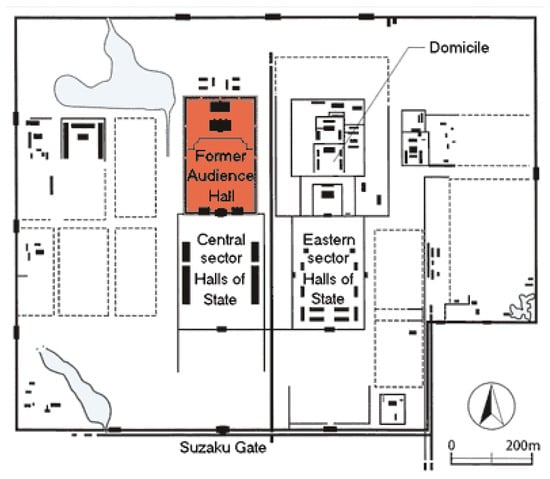
Figure 2. An image showing the scale of the Nara Palace Site (source: https://archaeology.jp/sites/2009/01heijo.htm (accessed on 18 December 2023)).
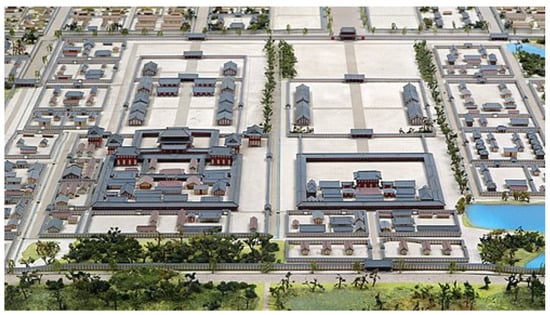
Figure 3. A 3D computer graphic visualizing Nara’s imperial city (source: Nabunken, 2004).
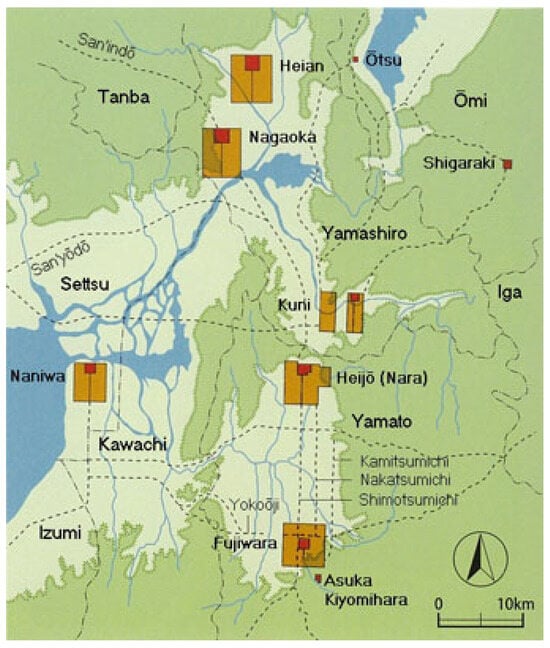
Figure 4. The movement of Nara’s capital city in the Yamato region (source: https://archaeology.jp/sites/2009/01heijo.htm (accessed on 18 December 2023)).
The Nara period in Japan was a short but volatile historical era that left behind a huge amount of cultural property across the country. Most of the related sites have been recognized by UNESCO as deserving of World Cultural Heritage status or are classified by the Japanese government as particularly important national heritage, such as the Toudaiji pagoda (東大寺, 760 CE), Houryuji pagoda (法隆寺, 607 CE) (Figure 5), Toshodaiji pagoda (唐招提寺, 710 CE), Koufukuji pagoda (興福寺, 685 CE), and Yakushiji Pagoda (薬師寺, 718 CE). This is especially true of the Nara Palace site, with its outstanding conservation achievements and reconstruction of Japanese architectural heritage.
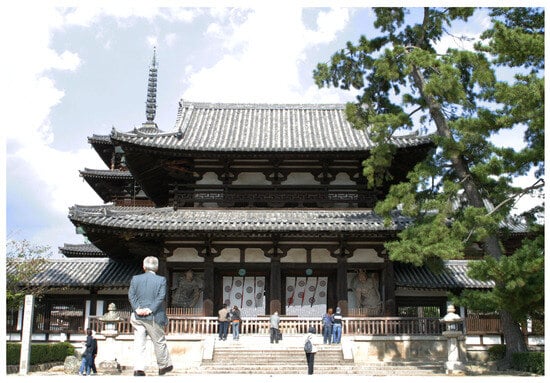
Figure 5. The Houryuji pagoda (法隆寺, 607 CE).
2. Discovery of the Nara Palace Site
Nowadays, the Nara Palace site is part of Nara City, where the court’s political power and the imperial residence were concentrated during the Nara period (710–784 CE), occupying an area of about 1/16 of the total area of Nara’s ancient capital city. Around 1916, Professor Sekino Tadasu (1867–1935) of the University of Tokyo began to survey the area of the Nara Palace site to find traces of the above-mentioned historically famous Heijokyu capital city. Randomly, he had received information from farmers about a hill called Daigoku, which reminded him of the historically recorded main palace of the Heijokyu as Daigokuden (大極殿). Then, in 1918, he conducted a probe excavation and discovered the first big basement stone of the Daigokuden [6]. Around 1923, a small-scale archaeological survey conducted by professors and archaeologists determined the exact location of the Nara Palace site. Probably at the same time, around 1912, Professor Ito Chuta (1867–1954) [7] of the University of Tokyo began to study ancient heritage buildings in Nara City, with a focus on the remaining Horyuji pagoda and the history of the Nara period. Although his research did not focus directly on the Nara Palace site, he made important and fundamental contributions to our understanding of the ancient Japanese architectural heritage and imparted important information about the history of the Nara periods, greatly contributing to the later reconstruction of the Nara Palace site.
Until around 2004, more than 130 hectares of farming land were surveyed and nearly 1/3 of that area was archaeologically assessed, including the foundations of the most important heritage buildings of the site. According to the topographic measurement and analysis results, the Nara Palace site had north and south sides of 1250 m and east and west sides of 1000 m. Because the site is located in the basin near the foot of the mountains, the terrain is flat but has a rather steep slope in a northeast–southwest direction. The alluvial soil layer in the south area is up to 3.5 m in depth, then in the north area, it is thin; the depositional formation only appears as the lower layer of the present ground level. However, on average, in the central area, the ground level of the Nara period is about 0.80 m lower than the present level [8].
In the late 1950s, a local railway company established an investment project and chose the southern area of the Nara Palace site for infrastructure construction. This project has met with fierce opposition from professors and researchers, who have repeatedly submitted petitions to the Japanese government requesting that they cancel the project and offering a long-term plan to protect this important heritage site. In the early 1960s, Professor Ota Hirotaro of Tokyo University (a student of Professor Ito Chuta) presented his objections directly to Prime Minister Ikeda Hayato (1960–1964) [9] of Japan at that time about the issue of the Nara Palace site, after which Prime Minister Ikeda Hayato decided to buy back the land comprising the area of the Nara Palace site, which has officially been under the management of the Japanese nation since the 1960s.
This entry is adapted from the peer-reviewed paper 10.3390/buildings14010132
This entry is offline, you can click here to edit this entry!
